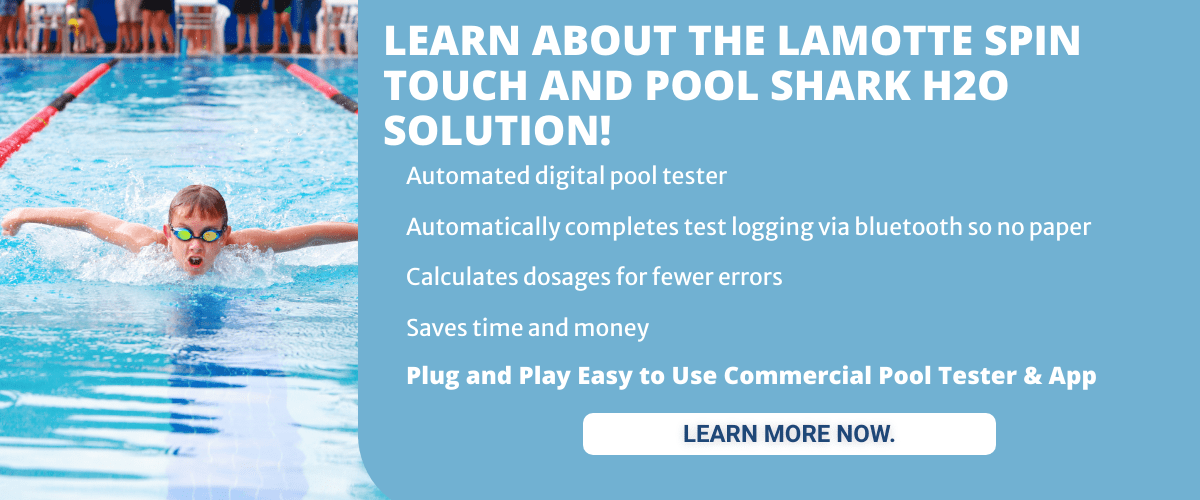
We all use sanitizer to keep our bodies of water safe. Chlorine is the most widely used form of sanitation. It is available in granular, liquid, and tablet form. Some of us may manually add it while others have chemical feeders. There comes a time in every pool operator’s life when we need to shock, or oxidize, our pools and such. How do we know whether we need a chlorine shock or a non-chlorine shock? Let’s chat about it.
Free Chlorine
This form of chlorine in our water is the one we should be most aware of. It is the killing form of chlorine. It combats organic and inorganic load, fights algae, helps keep the water clear and, most importantly, keeps our bathers safe. You should be testing often, including free chlorine in your tests. Whether you are using a manual DPD test kit where the chlorine turns pink, or have decided to be tech-smart and have paired the LaMotte Spin Lab with your Pool Shark H2O App, you will get your free chlorine reading in this handy app.
Total Chlorine
This is the measure of free chlorine and combined chlorine. We will talk more about combined chlorine next. It is important to know this field because once we oxidize, the total chlorine becomes free chlorine as contaminants are oxidized out of your swimming pool water. We never want our free chlorine to be above 5 ppm so again, test and consult your Pool Shark H2O App for readings.
Combined Chlorine
This form of chlorine is also known as what are called chloramines. Chlorine in this state is useless and non-killing. All it does is cause problems. It is ineffective in keeping the water safe. It can be irritating to its bathers. It has that smack-you-in-the-face, yucky chlorine smell. As prudent pool operators, we want to rid our water of this hazard as quickly as possible. The Pool Shark H2O App will also calculate your combined chlorine levels if you enter the free chlorine and total chlorine. If you are manually recording your results, to find your combined chlorine level simply subtract the free chlorine level from the total chlorine level. The number you get is your amount of chloramines aka combined chlorine. The Model Aquatic Health Code recommends shocking when combined chlorine levels are above 0.4 ppm (Parts per Million)
When to Shock a Pool
If you have new water, you need to use a chlorine shock to break down contaminants and organic load and create a chlorine reserve. If you are combating algae you will need to use a chlorine shock. Probably the most common reason to use chlorine shock is if you have combined chlorine, you need to shock the water to free up the chlorine. Shocking the water converts combined chlorine into free chlorine. We like that!
Chlorine Shock
Whether we are using Di-Chlor, Trichlor or CalHypo, shocking with chlorine does two things. It frees up the combined chlorine level and adds chlorine to the water. This is where knowing our total chlorine level comes in handy. If our total chlorine level is below 5 ppm, check with your local health department guidelines for maximum total chlorine levels, then we are safe to use a chlorine method to shock the water as it will add chlorine as well. If we do not consult our Pool Shark H2O App for a knowledge of total chlorine, then we can put ourselves in a dilly of a pickle. If our total chlorine is already 5 ppm or above and we add a chlorine shock, we run the risk of the chlorine level becoming too high. We then either need to use Thiotrine, which is a chlorine neutralizer, or close the pool until the levels go back down. A third, risky option, would be to keep the water as is and pray that the health department doesn’t swing by. You would also be doing your bathers a disservice as high chlorine levels can be irritating.
Another reason to use a chlorine shock would be an accidental fecal release (AFR). In this case, we WANT our chlorine to be high. The instructions on what to do can be found in your Pool Shark H2O App. An easy way to remember the chlorine levels needed are:
If its poo, its 2.0 ppm
If its runny, its 20 ppm
Non-Chlorine Shock
Non-chlorine shock simply oxidizes those contaminants and organic load right out of the water. It does not add sanitizer. Notice I said it doesn’t “add” instead of it doesn’t “increase”. Nay, non-chlorine shock absolutely can increase your free chlorine level. It does this by getting rid of the combined chlorine and releasing it to fly free as, you guessed it, free chlorine. If your total chlorine level is 5 ppm or higher, then you would use a non-chlorine shock. My favorite part of non-chlorine shock is that bathers can re-enter the water just fifteen minutes after oxidizing with this type of shock. Whereas with chlorine shock, they would need to stay out for hours. Even longer if the chlorine gets too high like we discussed above. Please be advised you CANNOT use non-chlorine shock in an AFR.
Testing
I know I harp on this in all of our articles, but I simply cannot stress it enough, Test, Test Test! The more you test your water, the healthier your water will be. This helps keep the water safe, keeps the pool open, keeps the health department happy, protects your equipment and protects your vessel. With the Pool Shark H2O App, you can shock away with confidence knowing you are using the correct amount of shock. It also gives you many other fields along with proper dosing instructions to help you maintain a balanced pool. Pool Shark H2O to the rescue again! See you poolside!
More Commercial Pool Chemistry Resources
Free, vs Combined vs Total Chlorine - A Guide for Commercial or Public Pool Operators
Why Being Able to Calculate the Volume of a Commercial or Public Swimming Pool is Important
Cyanuric Acid Levels in Swimming Pools
Ideal Alkalinity in Commercial Pools
Managing pH and Alkalinity in Pools
Commercial Pool Chlorine Management
Cyanuric Acid in Your Pool Too High? How to Remove Cyanuric Acid (Lower Pool Stabilizer)
Lowering Alkalinity in Swimming Pools
Reasons Your Public or Commercial Pool Water Could Be Cloudy
Muriatic Acid in Swimming Pools
How to Lower pH in Pools, Water Parks and Water Features
Does Chlorine Kill Poop in a Swimming Pool?
Total Dissolved Solids: When Should I Drain My Pool?
Why Pool Chemical Storage Cabinets are Important for Commercial Pools
Storing Pool Chemicals: What Commercial Pool Operators Need to Know



